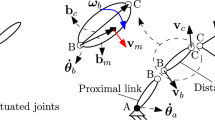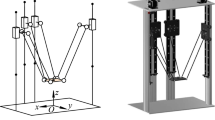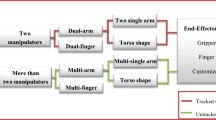Abstract
A 3-degree-of-freedom (3-DOF) parallel machine tool based on a tripod mechanism is developed and studied. The kinematics analysis is performed, the workspace is derived, and an analysis on the number of conditions of the Jacobian matrix and manipulability is carried out. A method for error analysis and manipulability is introduced. Hence, the manipulability analysis of the parallel machine tool is accomplished.
Similar content being viewed by others
References
M. Suzuki, K. Watanabe, T. Shibukawa, T. Tooyama, K. Hattori. Development of milling machine with parallel mechanism. Toyota Technical Review, vol. 47, no. 1, pp. 125–130, 1997.
T. Onshoff, H. Soehner, C. Ahlers. A new machine tool concept for laser machining. In Proceedings of International Seminar on Improving Machine Tool Performance, San Sebastian, pp. 199–124, 1998.
A. Kochan. Parallel robots perfect propellers. Industrial Robot: An International Journal, vol. 23, no. 4, pp. 27–30, 1996.
M. Weck, D. Staimer. Parallel kinematic machine tools — Current state and future potentials. CIRP Annals — Manufacturing Technology, vol. 51, no. 2. pp. 671–683, 2002.
D. Chablat, P. Wenger. Architecture optimization of a 3- DOF translational parallel mechanism for machining applications, the orthoglide. IEEE Transactions on Robotics and Automation, vol. 19, no. 3, pp. 403–410, 2003.
G. Q. Cai, M. Hu, C. Guo, B. Li, Q. M. Wang. Development and study of a new kind of 3-DOF tripod. CIRP Annals — Manufacturing Technology, vol. 48, no. 1, pp. 333–336, 1999.
P. Chiacchio, S. Chiaverini, L. Sciavicco, B. Siciliano. Global task space manipulability ellipsoids for multiple-arm systems. IEEE Transactions on Robotics and Automation, vol. 7, no. 5, pp. 678–685. 1991.
R. P. Paul, C. N. Stevenson. Kinematics of robot wrists. International Journal of Robotics, vol. 2, no. 1, pp. 31–38, 1984.
Y. Lu. Using CAD variation geometry for solving velocity and acceleration of parallel manipulators with 3–5 linear driving limbs. ASME Transactions: Journal of Mechanical Design, vol. 128 no. 4, pp. 738–746. 2006.
Z. Q. Hou, Y. D. Cheng, Z. F. Tong, Y. M. Sun, N. Y. Lu. Modal parameter identification from multi-point measured data. In Proceedings of the 3rd International Modal Analysis Conference, Orlando, USA, pp. 28–31, 1985.
D. Xu, C. A. A. Calderon, J. Q. Gan, H. S. Hu, M. Tan. An analysis of the inverse kinematics for a 5-DOF manipulator. International Journal of Automation and Computing, vol.2 no. 2. pp. 114–124, 2005
K. H. Low. Locomotion and depth control of robotic fish with modular undulating fins. International Journal of Automation and Computing, vol. 3 no. 4. pp. 348–357, 2006.
Author information
Authors and Affiliations
Corresponding author
Additional information
This work was supported by University Key Laboratory Foundation of Liaoning Province of China (No. 2008S094)
Ming Hu received the bachelor and master degrees in mechanical engineering from the Jinzhou Institute of Technology and Northeastern University, PRC in 1984 and 1991, respectively, and the Ph.D. degree in mechanical engineering at Northeastern University, PRC in 1999. He is currently an associate professor at the School of Mechanical Engineering and Automation, Northeastern University.
His research interests include robotics, concentrator network controller (CNC), and control theory.
Jia-Shun Shi received the bachelor and master degrees in mechanical engineering from the Jinzhou Institute of Technology and Northeastern University, PRC in 1985 and 1993, respectively. He is currently an associate professor at the School of Mechanical Engineering and Automation, Northeastern University.
His research interests include robotics, concentrator network controller (CNC), and control theory.
Rights and permissions
About this article
Cite this article
Hu, M., Shi, JS. The kinematic analyses of the 3-DOF parallel machine tools. Int. J. Autom. Comput. 8, 107–111 (2011). https://doi.org/10.1007/s11633-010-0561-1
Received:
Revised:
Published:
Issue Date:
DOI: https://doi.org/10.1007/s11633-010-0561-1




